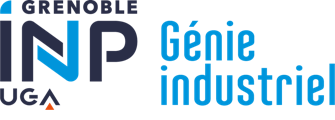Number of hours
- Lectures -
- Projects -
- Tutorials -
- Internship -
- Laboratory works -
- Written tests 3.0
ECTS
ECTS 6.0
Goal(s)
The course is taught in French (some e-learning activities are in English).
Acquire skills in integer linear programming, dynamic programming and graph theory to model and solve complex logistics problems.
Understanding the role of Operations Research in our industrial society.
Three expectations:
1- Knowing the tools: Knowing the objects handled (mastering the terminology of linear programming, dynamic programming and graphs, knowing how to use the right vocabulary in describing a problem and solving it);
2- Know how to apply the tools: know and know how to carry out simple reasoning (provide proofs for linear programming and graphs, know how to propose recurrence formulas for dynamic programming), and know and know how to carry out basic graph algorithms (basic linear programming algorithms are expected to be mastered, see Prerequisites);
3- Identify the right tools to solve concrete problems: Model concrete problems using the tools seen in class, and deduce the algorithm(s) needed to solve the problem. Take a step back to reflect on modeling choices and their associated societal and environmental impacts.
Content(s)
The course follows the principle of reverse pedagogy. It therefore requires a high degree of autonomy and personal organization. Working together in a small team (3 to 5 students) enables students to exchange and share their knowledge, which in turn leads to better progress and more solid learning.
The course is organized around :
- Learning sequences (validation of expectations 1 and 2) :
- Independent reading (CM for PLNE);
- Application and modeling exercises to be prepared and Caseine activities to be carried out before the TD;
- A review with the TD teacher, who will answer any questions and clarify any points that have caused difficulties;
- An assessment to validate the sequence.
- Case studies (in groups of 3 to 4 students) (validation of expectations 1, 2 and 3):
- Model the problem posed;
- Solve the problem using the tools provided (Python, PL solver);
- Write a synthesis;
- Oral presentation of results.
- A work on the map of the limits of industrial thinking (in groups of 3 to 4 students):
- Explore the map by following lines of inquiry;
- Read texts and provide key ideas.
- Final exam (validation of expectations 1, 2 and 3):
Contents
Content of the eight learning sequences :
- Session 1: Graph theory: basic concepts;
- Seq. 2a: Chain, cycle, path, circuit;
- Seq. 2b: Minimum-weight spanning trees;
- Seq. 3: Shortest path;
- Session 4: Dynamic programming;
- Seq. 5: Maximum flow and minimum cost flow;
- Seq. 6: Integer linear programming;
- Seq. 7: Modeling concrete problems.
Content of the case studies :
- Case Study 1: Dynamic Programming - modeling and solving a problem (Python programming language);
- Case Study 2: Integer Linear Programming - modeling and solving a problem (OPL - Cplex).
Content of the study on the map of the limits of industrial thinking:
- Lecture presenting the lines of inquiry on the map;
- Reading workshops in tutorial format.
The course requires knowledge of :
- Linear programming: Linear Programming modeling, simplex algorithm, duality, economic interpretation (see description of UE Mathématiques et informatique décisionnelles - 3GUC0905)
- Algorithms and programming: basic notions of algorithms and mastery of a high-level programming language (e.g. Python) (see description of UE Modélisation mathématique et informatique
- 3GUC0205 and UE Mathématiques et informatique décisionnelles - 3GUC0905).
Session 1
The assessment of the following activities leads to the determination of the final grade for the UE :
- End-of-sequence activity in Caseine (8 activities);
- Case studies (2 case studies);
- Final exam (3h written exam with one recto-verso of personal notes and calculator allowed).
The course is validated when the mark vector produces a mark higher than 10/20.
See grade calculation for details.
Make-up session
Assessment is based solely on a written exam (2-hour written exam with one recto-verso of personal notes and calculator authorized).
The jury may decide to allow the student to progress to the next year, subject to deferred validation of this UE. This decision remains exceptional; the jury is sovereign for each student.
Le calcul de la note finale est compatible avec une organisation des enseignements et des examens en distanciel.
Chaque activité est notée :
• Activité de fin de séquence sous Caseine (A, B ou F);
• Études de cas (A, B, C ou F);
• Examen terminal (A, B, C, D ou E).
Le cours est validé lorsque le vecteur de notes produit une note supérieure à 10/20.
Le calcul de la note finale à l'UE se fait en fonction du vecteur de notes suivant :
(EF:examen final | 2 études de cas | 8 évaluations de fin de séquences de formation);
Par exemple le vecteur (B | AB | AAAAAABB) signifie que l’étudiant.e a obtenu :
• B à l’examen;
• A et B aux études de cas;
• A à 6 des évaluations de fin de séquences et B à 2 de ces évaluations.
Voici les vecteurs minimaux qu’il faut obtenir pour avoir les notes suivantes :
– 20/20 :
• (A | AB | AAAAAABB)
• (B | AA | AAAAAAAB)
– 16/20 :
• (B | BC | AAAAABBB)
• (C | AB | AAAAAABB)
– 12/20 :
• (C | BC | AAAAABBB)
• (D | BB | AAAAAABB)
• (B | CC | AAAAAAAB)
– 08/20 : Tout vecteur inférieur sans F;
– 06/20 : Tout vecteur avec un F;
– 04/20 : Tout vecteur avec deux F;
– 00/20 : Tout vecteur avec trois F ou plus;
Quelques exemples :
• (B | AA | AAAAAAAB) donne 20/20
• (A | BB | AAAAAABB) donne 16/20
• (A | AC | AAAAAAAA) donne 16/20
• (D | AB | AAAAAAAB) donne 12/20
• (B | CC | AAAAAAAA) donne 12/20
• (A | AA | AAAABBBB) donne 08/20
• (B | CC | AAAAAABB) donne 08/20
• (E | AA | AAAAAAAA) donne 08/20
• (A | AA | AAAAAAAF) donne 06/20
• (A | AF | AAAAAAAA) donne 06/20
• (A | AF | AAAAAAAF) donne 04/20
• (A | AA | AAAAAFFF) donne 00/20
The course exists in the following branches:
- Curriculum - Engineer student Master SCM - Semester 7
Course ID : 4GUL0209
Course language(s): 
You can find this course among all other courses.
C. Guéret, C. Prins, M. Sevaux, Programmation lineaire: 65 problèmes modélisés et résolus avec l'outil Visual Xpress, Eyrolles, 2000.
V. Giard, Gestion de la production et des flux, Economica, 2003.
H. Stadtler, C. Kilger, Supply Chain Management and Advanced Planning, Springer, 2002.
Y. Pochet, L.A. Wolsey, Production Planning by Mixed Integer Programming, Springer, 2006.
M. Minoux, M. Gondran, Graphes et Algorithmes, Lavoisier, 2009.
French State controlled diploma conferring a Master's degree

Common Core presentation
Programme courses S5
Programme courses S6
Supply Chain Management
Programme presentation
Programme courses S7
Programme courses S8
Programme courses S9
Programme courses S10
Product Design
Programme presentation
Programme courses S7
Programme courses S8
Programme courses S9
Programme courses S10
Contacts
Academic staff
- Head of studies:
Pierre Lemaire - Head of 1st Year Program:
Abdourahim Sylla - Head of Supply Chain Management Program:
Irène Gannaz - Head of Product design Program:
Yann Ledoux
Registrar's office
- Head of Registrar's office:
genie-industriel.scolarite@grenoble-inp.fr - Secretary's office 1st Year:
Valérie Demicheli - Secretary's office 2nd Year:
Sylvie Malandrino - Secretary's office 3rd Year:
Vincente Odier - International relations department:
Nadia Dehemchi



